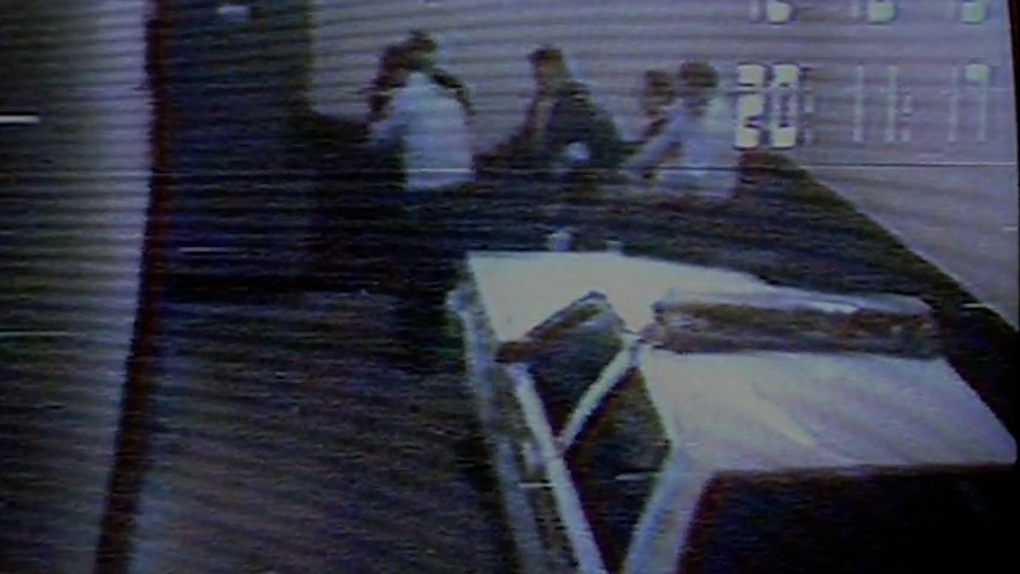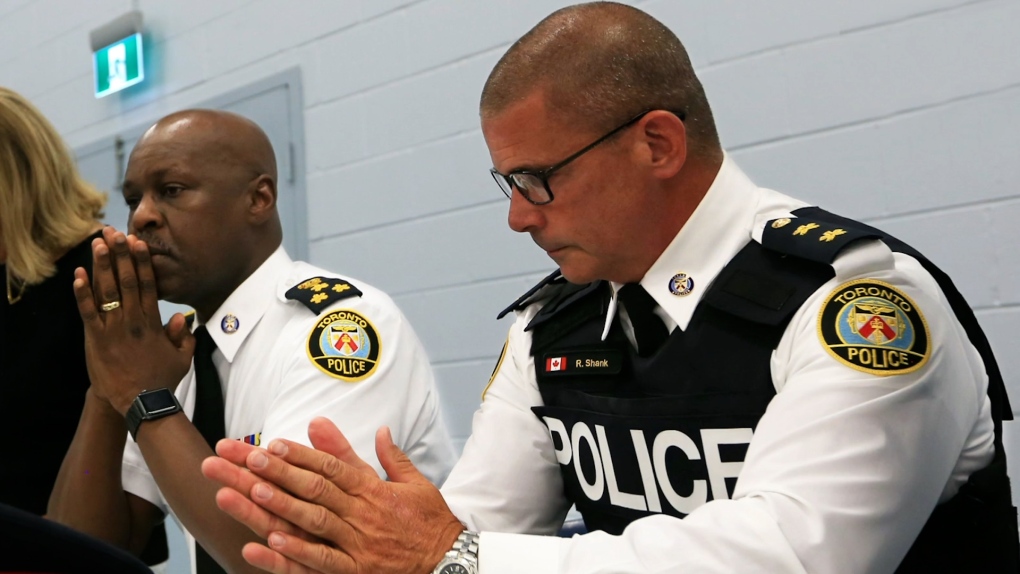Decades-old killings, beating of Black men spark outcry around Toronto police promotion
Some members of Toronto’s Black community are raising concerns after a police officer who was cleared after killing two Black men and was accused of beating a third some three decades ago is now the head of the Toronto police’s professional standards unit.
The appointment of Supt. Rick Shank was made in the midst of a stay-at-home order during the pandemic two years ago. The professional standards unit is responsible for internal accountability and public confidence in the police.
But those goals may be much harder to reach when Shank’s history is taken into consideration, which includes a photo obtained by CTV News that shows Shank as a young constable holding up his bloody knuckles after one incident in 1993.
“The signal that you’re sending to the general public and your own police officers is you can get away with whatever you want and you’ll be rewarded,” said author and activist Desmond Cole, who wrote about the appointment last week.
- Download our app to get local alerts on your device
- Get the latest local updates right to your inbox
In a statement, the Toronto Police Service (TPS) said the force found no misconduct in those incidents and Shank was not convicted, adding that focusing on those incidents in the 1990s misrepresents who he is both as a person and a police officer.
“Superintendent Shank has served as a police officer for over 30 years with an exemplary record and is recognized for his many contributions to policing. Over the course of his career, he has demonstrated the highest levels of professionalism, ethics and leadership, and has a record of service to the community. We stand by Superintendent Shank and his service,” the TPS said.
In 1993, Rick Shank shot and killed 20-year-old Ian Coley. Shank claimed the 20-year-old had pointed a gun at him. He was cleared by the Special Investigations Unit (SIU), which found that “Const. Shank instinctively used deadly force to justifiably protect himself.”
Questions were raised at the Coroner’s Inquest about Shank working alongside what was then known as the “Black Organized Crime Squad.”
“It seems this unit gives extra policing of people in the Black community over and above all the normal policing,” Coley’s family’s lawyer, Peter Rosenthal, told CTV News at the time.
Among the coroner’s jury recommendations were to disband the squad and to stop using the phrase “non-white” in police communications.
Shank and others were accused in a lawsuit of beating a young Black man in December of that year. A video obtained by CTV News shows 29-year-old Paul Reece being hauled, unconscious, from a police vehicle. His head hits the side of the police car.
Once in the station, he’s told by an officer, “You’re under arrest for assault with intent to resist arrest.” Reece replies, “I never assaulted nobody.”
 Video shows Paul Reece being dragged from a police video in 1993.
Video shows Paul Reece being dragged from a police video in 1993.
Reece claimed Shank and others had beaten him at a cemetery on the way to the police station after an arrest in a traffic stop that turned into a melee in his family’s home. A police photo taken after that incident shows Shank demonstrating his bloody knuckles for the camera.
Reece’s mother Claudette said in an interview at the time that she was punched in the stomach and grabbed around the neck when police came to the door. She said when the family tried to follow the police vehicle, with their son inside, other cars boxed them in.
The trial judge threw out the charges against Reece, saying Shank was not executing his duties lawfully in the arrest. An appeals judge decided not to order a new trial, saying, “the evidence suggests that the actions of participants on both sides left much to be desired and far less than is properly expected by the community at large.”
The Toronto police say the SIU found there was no evidence to corroborate Reece’s claim of serious injury, which is the standard when the civilian investigators get involved. The force says Shank did not face any internal misconduct charges at the time either.
Reece sued for $7 million and the lawsuit settled out of court, according to reports at the time.
In 1997, Shank shot Hugh Dawson nine times as he sat in his driver’s seat, unarmed, in a drug bust. Shank was charged with manslaughter, a charge that led first to a hung jury, and then an acquittal, with Shank noted for a Toronto police first—killing two people.
Jack Ritchie of the Metropolitan Police Association said at the time, “He’s had this happen to him twice. He knows what it’s like, he’s been through it, he must be living a nightmare.”
Decades later, in February 2021, Toronto’s Police Board approved Shank’s promotion to a superintendent. He was assigned by the chief to lead professional standards.
The appointment was in the midst of a stay-at-home order during the pandemic, with the board meetings being conducted over zoom. A video recording of the motion shows no discussion before the vote.
Looking at the appointment today, the promotion sends the wrong message, said former Toronto Mayor John Sewell.
“The bigwigs in the Toronto Police Service all said, ‘This is perfectly fine.’ I think what it means is that this is a real demonstration of police culture, where it’s so ingrained in police, the violence, discrimination against racialized people, it’s not a big problem,” he said.
 Toronto police Supt. Rick Shank is seen in this photograph alongside former chief Mark Saunders.
Toronto police Supt. Rick Shank is seen in this photograph alongside former chief Mark Saunders.
The promotion did meet eligibility requirements and internal references, said a Toronto Police spokesperson, adding they have been clear in their commitment to confront anti-Black racism and over the past several years have been working harder than ever to promote equitable, fair, and non-discriminatory policing.
CTVNews.ca Top Stories

Young people 'tortured' if stolen vehicle operations fail, Montreal police tell MPs
One day after a Montreal police officer fired gunshots at a suspect in a stolen vehicle, senior officers were telling parliamentarians that organized crime groups are recruiting people as young as 15 in the city to steal cars so that they can be shipped overseas.
Man sets self on fire outside New York court where Trump trial underway
A man set himself on fire on Friday outside the New York courthouse where Donald Trump's historic hush-money trial was taking place as jury selection wrapped up, but officials said he did not appear to have been targeting Trump.
Sask. father found guilty of withholding daughter to prevent her from getting COVID-19 vaccine
Michael Gordon Jackson, a Saskatchewan man accused of abducting his daughter to prevent her from getting a COVID-19 vaccine, has been found guilty for contravention of a custody order.
She set out to find a husband in a year. Then she matched with a guy on a dating app on the other side of the world
Scottish comedian Samantha Hannah was working on a comedy show about finding a husband when Toby Hunter came into her life. What happened next surprised them both.
Mandisa, Grammy award-winning 'American Idol' alum, dead at 47
Soulful gospel artist Mandisa, a Grammy-winning singer who got her start as a contestant on 'American Idol' in 2006, has died, according to a statement on her verified social media. She was 47.
Shivering for health: The myths and truths of ice baths explained
In a climate of social media-endorsed wellness rituals, plunging into cold water has promised to aid muscle recovery, enhance mental health and support immune system function. But the evidence of such benefits sits on thin ice, according to researchers.
'It could be catastrophic': Woman says natural supplement contained hidden painkiller drug
A Manitoba woman thought she found a miracle natural supplement, but said a hidden ingredient wreaked havoc on her health.
The Body Shop Canada explores sale as demand outpaces inventory: court filing
The Body Shop Canada is exploring a sale as it struggles to get its hands on enough inventory to keep up with "robust" sales after announcing it would file for creditor protection and close 33 stores.
Vicious attack on a dog ends with charges for northern Ont. suspect
Police in Sault Ste. Marie charged a 22-year-old man with animal cruelty following an attack on a dog Thursday morning.
































